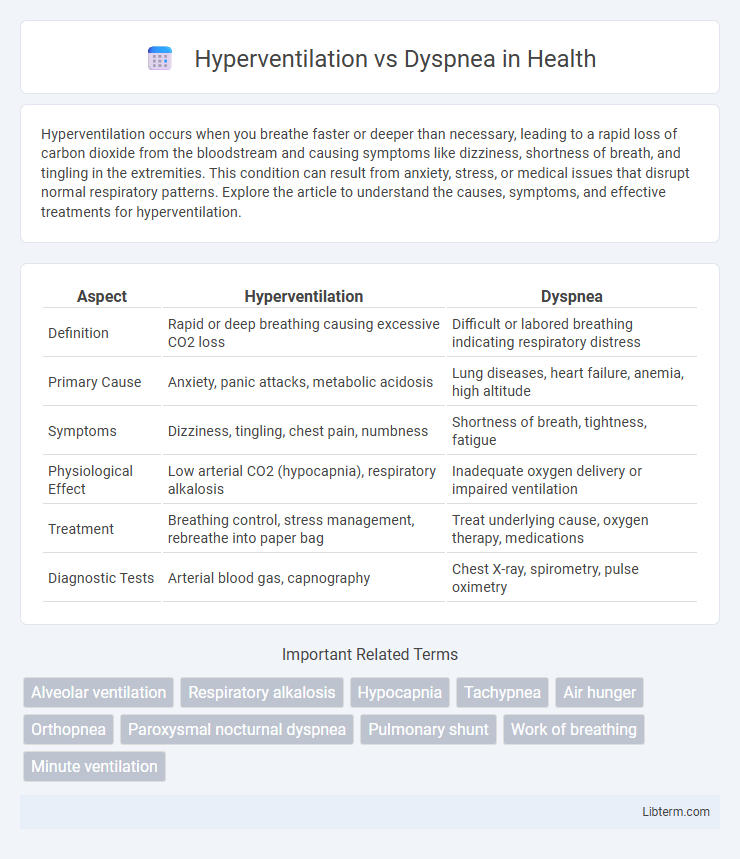Hyperventilation occurs when you breathe faster or deeper than necessary, leading to a rapid loss of carbon dioxide from the bloodstream and causing symptoms like dizziness, shortness of breath, and tingling in the extremities. This condition can result from anxiety, stress, or medical issues that disrupt normal respiratory patterns. Explore the article to understand the causes, symptoms, and effective treatments for hyperventilation.
Table of Comparison
| Aspect | Hyperventilation | Dyspnea |
|---|---|---|
| Definition | Rapid or deep breathing causing excessive CO2 loss | Difficult or labored breathing indicating respiratory distress |
| Primary Cause | Anxiety, panic attacks, metabolic acidosis | Lung diseases, heart failure, anemia, high altitude |
| Symptoms | Dizziness, tingling, chest pain, numbness | Shortness of breath, tightness, fatigue |
| Physiological Effect | Low arterial CO2 (hypocapnia), respiratory alkalosis | Inadequate oxygen delivery or impaired ventilation |
| Treatment | Breathing control, stress management, rebreathe into paper bag | Treat underlying cause, oxygen therapy, medications |
| Diagnostic Tests | Arterial blood gas, capnography | Chest X-ray, spirometry, pulse oximetry |
Understanding Hyperventilation
Hyperventilation is a condition characterized by rapid or deep breathing that causes excessive expulsion of carbon dioxide, leading to respiratory alkalosis and symptoms such as dizziness, tingling, and shortness of breath. Unlike dyspnea, which is the subjective experience of breathing discomfort often linked to underlying cardiopulmonary diseases, hyperventilation primarily results from anxiety, metabolic imbalances, or neurological triggers. Accurate differentiation involves measuring arterial blood gases and monitoring respiratory patterns to ensure proper diagnosis and targeted management.
Defining Dyspnea
Dyspnea, defined as the subjective sensation of breathlessness or difficulty breathing, differs from hyperventilation, which is characterized by rapid or deep breathing that exceeds the body's metabolic demands. Dyspnea often signals underlying respiratory or cardiac conditions such as chronic obstructive pulmonary disease (COPD), asthma, or heart failure, requiring clinical evaluation for accurate diagnosis. Understanding dyspnea's multifactorial causes helps differentiate it from hyperventilation, which primarily involves altered breathing patterns linked to anxiety or metabolic imbalances.
Key Differences: Hyperventilation vs Dyspnea
Hyperventilation involves rapid or deep breathing leading to excessive carbon dioxide expulsion, often causing dizziness and tingling sensations, whereas dyspnea refers to the subjective experience of breathlessness or difficulty breathing. Hyperventilation is primarily a physiological response that can be triggered by anxiety, metabolic acidosis, or hypoxia, while dyspnea is a symptom associated with various cardiac, respiratory, or systemic conditions such as asthma, chronic obstructive pulmonary disease (COPD), or heart failure. Clinically, hyperventilation is identified by decreased arterial CO2 (hypocapnia), contrasting with dyspnea, which requires comprehensive evaluation of underlying causes affecting oxygen delivery and respiratory mechanics.
Common Causes of Hyperventilation
Hyperventilation commonly arises from anxiety, panic attacks, or stress, leading to rapid and shallow breathing that disrupts normal carbon dioxide levels in the blood. Other causes include metabolic acidosis, hypoxia, fever, and certain medications that affect respiration. Differentiating hyperventilation from dyspnea involves recognizing that dyspnea primarily refers to the subjective sensation of breathlessness, often linked to underlying cardiac or pulmonary conditions like asthma, COPD, or heart failure.
Typical Causes of Dyspnea
Dyspnea commonly results from underlying cardiac or pulmonary conditions such as chronic obstructive pulmonary disease (COPD), congestive heart failure, asthma, or pneumonia, which impair oxygen exchange and respiratory function. Other typical causes include anemia, anxiety disorders, and obesity, all of which can increase the body's demand for oxygen or reduce respiratory efficiency. Differentiating dyspnea from hyperventilation involves assessing respiratory rate and depth, as hyperventilation often stems from anxiety or metabolic imbalances leading to excessive carbon dioxide elimination.
Symptoms Comparison: Hyperventilation and Dyspnea
Hyperventilation is characterized by rapid, deep breathing leading to symptoms such as dizziness, tingling in the hands, and lightheadedness due to decreased carbon dioxide levels. Dyspnea presents as an uncomfortable or labored sensation of breathlessness, often accompanied by chest tightness, wheezing, or coughing, typically linked to underlying cardiac or pulmonary conditions. While both involve respiratory distress, hyperventilation primarily affects breathing rate and blood gas balance, whereas dyspnea reflects a subjective feeling of breathing difficulty.
Diagnostic Approaches for Both Conditions
Hyperventilation is diagnosed primarily through clinical evaluation and arterial blood gas analysis revealing decreased carbon dioxide levels, while dyspnea assessment involves pulse oximetry, chest X-rays, and spirometry to identify underlying respiratory or cardiac causes. Capnography helps distinguish hyperventilation by measuring end-tidal CO2, contrasting with dyspnea, which requires broader diagnostic tools like echocardiography or CT scans depending on suspected etiology. Both conditions benefit from detailed patient history and physical examination to guide targeted testing and accurate diagnosis.
Treatment Options for Hyperventilation
Treatment options for hyperventilation primarily include breathing techniques such as controlled, slow diaphragmatic breathing to restore carbon dioxide levels. Cognitive-behavioral therapy and relaxation exercises help address underlying anxiety that often triggers hyperventilation episodes. In some cases, supplemental oxygen or rebreathing into a paper bag may be used temporarily, although this approach is less commonly recommended due to risks.
Managing and Treating Dyspnea
Managing and treating dyspnea involves identifying and addressing the underlying causes such as chronic obstructive pulmonary disease, heart failure, or anxiety disorders. Effective treatments include supplemental oxygen therapy, bronchodilators, corticosteroids, and pulmonary rehabilitation to improve lung function and reduce breathlessness. Non-pharmacological approaches like breathing exercises, relaxation techniques, and psychological support can significantly enhance patient comfort and quality of life.
When to Seek Medical Attention
Seek medical attention immediately if hyperventilation causes persistent dizziness, chest pain, or fainting, as these symptoms may indicate underlying serious conditions like cardiac or respiratory disorders. Dyspnea warrants urgent evaluation when it presents suddenly, worsens rapidly, or is accompanied by cyanosis, altered mental status, or severe chest pain, suggesting potential causes like pulmonary embolism, asthma exacerbation, or heart failure. Persistent or unexplained episodes of either condition should be assessed by a healthcare professional to identify and treat potential life-threatening causes.
Hyperventilation Infographic

 libterm.com
libterm.com